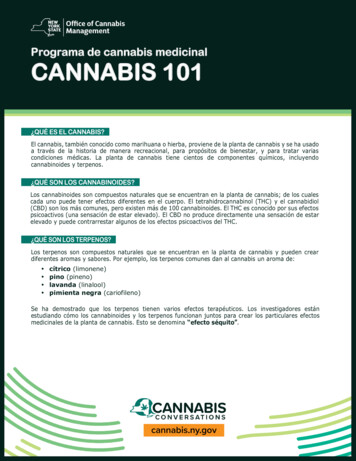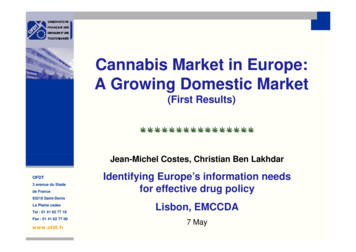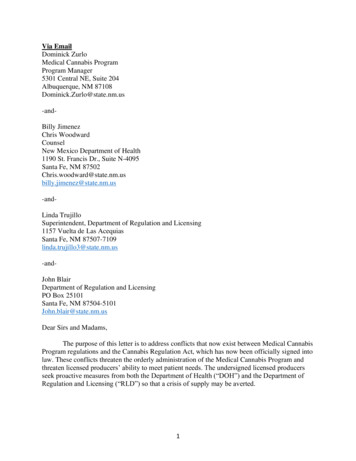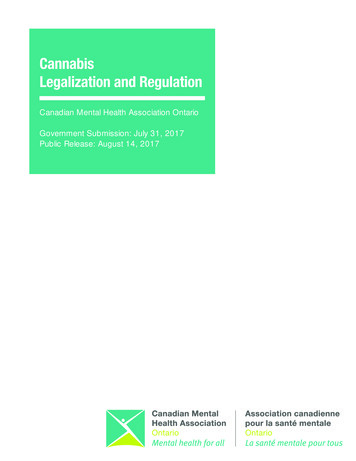
Transcription
Guidance for StateMedical CannabisTesting ProgramsMAY 2016
Table of ContentsAcknowledgments. 4Introduction . 5Risk Assessment . 5Types of Product. 6Characteristics of Various Forms. 9Dealing with Schedule I Materials . 9Analytes and Action Levels. 14Pesticides. 14Solvents. 17Microbiologicals. 22Metals. 26Cannabinoids. 26Sampling and Analysis . 26Sample Collection. 27Sample Analysis. 28Pesticides. 28Solvents. 28Metals. 30Cannabinoid Profile. 30Laboratory Certification/Registration/Accreditation . 32Colorado. 32New York. 32Oregon. 34Washington. 34Outreach. 34Efficacy & Side Effects of the Products . 34Appendix: Links to State Programs, Laws, Regulations . 35Maine. 35Maryland. 35Massachusetts. 35Nevada. 35New York. 35Table of FiguresTable 1: Pesticide analytes and their action levels in OR. 16Table 2: USP Chapter 467 Solvents and their concentration limit. 18Table 3: List of solvents and their action levels. 20Table 4: Solvent maximum concentration limits by state. 21Table 5: US Pharmacopeia Microbial Limits. 23
AcknowledgmentsKenneth Aldous, PhDDirector, Division of Environmental Health SciencesWadsworth Center, NYS Department of Healthand Associate Professor, School of Public HealthState University at AlbanyJeremy ApplenCo-founderCanopy SystemsZhihua (Tina) Fan, PhDResearch Scientist/Program ManagerChemical Terrorism, Biomonitoring and Food TestingNew Jersey Department of HealthPublic Health Infrastructure, Laboratories & Emergency Preparedness.Public Health & Environmental LaboratoriesMary A. Fox, PhD MPHAssistant Professor, Health Policy and ManagementActing Director, Risk Sciences and Public Policy InstituteJohns Hopkins Bloomberg School of Public HealthShawn KassnerSenior ScientistNeptune and Company, Inc.Megan Weil Latshaw, PhD MHSDirector, Environmental Health ProgramsAssociation of Public Health LaboratoriesMarc A. Nascarella, PhDChief ToxicologistDirector, Environmental ToxicologyMassachusetts Department of Public HealthGary Starr, MDFOCUS StandardsShannon SwantekORELAP Compliance SpecialistOregon Public Health LabDavid VerbruggeManager, Analytical ToxicologyState of Alaska Public Health Lab4ASSOCIATION OF PUBLIC HEALTH LABORATORIES
IntroductionAs part of the nation’s public health infrastructure, state and federal agencies establish programsto protect population health. There are a wide variety of programs in place in different agenciesthat test, monitor and evaluate whether human exposures from the use of air, water or consumerproducts (including food and drugs) present potential risks to health.On the basis of these testing and evaluation programs, agencies have authority to protect ourhealth by taking action to ensure that air, water, and consumer products are of good quality.Protecting resources and consumer products may take many forms, e.g., preventing contamination(pollution prevention, regulating production processes), reducing or preventing exposure (recallingcontaminated products) or restricting uses such that health protective conditions are met andmaintained. In the case of drugs, including cannabis, public health agencies have concerns for thequality, therapeutic benefit, and the balance between therapeutic benefit and possible side-effects.Medical cannabis has been approved for use in a number of states but remains outside federalcontrol. As has been reported, the absence of federal guidance when it comes to cannabis testinghas led states to develop their own approaches. Since 2014, the Association of Public HealthLaboratories (APHL) has convened a monthly community of practice call so that member laboratoriescould share questions, advice, lessons learned and resources. During these calls, a theme emergedwhere every new participant asked the same questions as others who came before. In order tocollect the knowledge being shared, APHL created this guidance document.The main audience for this document is laboratorians who are being asked to develop newcannabis testing programs. It can also be used to assess existing programs. Other audiences mayinclude state legislators and their staff, state health officials, and those working in the cannabisindustry.Since the guidance was developed by a workgroup, it is heavily weighted toward those states thatparticipated in its writing. If you would like to add your perspective or suggest edits, please emaileh@aphl.org. Given the rapid changes in this field, APHL views this as a living document.Risk AssessmentThere are various approaches to the assessmentand management of hazards that can be appliedto cannabis programs. Drawing upon the variety oftools and methods applied in product evaluation andprotection programs for other types of products suchas food or drugs,1 the product protection pyramididentifies activities implemented by public healthagencies and by producers/product handlers toevaluate and ensure product quality. At the base ofthe pyramid, growers and processors implement goodpractices (maintaining growing facilities, appropriateuse of insecticides, etc).Product Protection PyramidProduct protection pyramidHealthRisks andBenefitsAgency-levelProgramsRisk AnalysisProduct Testing andHealth SurveillanceHACCP ProgramsProductionlevelProgramsGood Production PracticesAdapted from Gorris 2005A Hazard Analysis and Critical Control Point (HACCP)program is a management system designed to ensureproduct quality from production to consumption. HACCP programs are developed to be specific toeach type of process, along the production, distribution and consumption continuum. Public health1Gorris 2005. Food safety objective: An integral part of food chain management. Food Control 16: 801–809.Guidance for State Medical Cannabis Testing Programs5
agencies conduct product testing and health surveillance programs; the resulting data can be usedfor risk analysis to understand the potential health risks and benefits of cannabis products. Resultsof risk analysis inform HACCP and good production practices.There are three types of data collected, evaluated and combined in a risk assessment: Sources/Hazards (contaminants, pesticides, microbes or active ingredients) Health effects/consequences/adverse events associated with each hazard Exposure which involves sampling of products to determine concentrations of ingredients/contaminants and human exposure through use of the target product. Exposure scenariosreflect known uses of the product and include a range of scenarios from low to high exposuredepending on difference uses. They can also include human biomonitoring data—looking forthe analyte or its metabolite in human specimens, such as blood lead testing.2Using the estimation of risks, based on the exposure-hazard-health effect sets, public health canbetter characterize risk and develop health protective approaches to managing it. Practitioners mayuse screening approaches—risk ranking to identify the highest risk products, risk-driving hazards orrisk-driving processes—to inform product warnings and further sampling.In order to develop a standard, practitioners must develop criteria for “acceptable risk” and identifyexposure-use scenarios that fall within or outside the acceptable risk criteria. Based on thatstandard, it is possible to establish mechanisms for removal of products or to limit usage so thathuman exposures remain below the acceptable risk criterion.Types of ProductAs with most programs in the United States, every state takes a different approach. For example asof January 2016, New Jersey’s Public Health & Environmental Laboratories only test cannabis plantmaterial. Just across the Hudson, however, New York’s Public Health Laboratory will not be testingany plant material, only cannabis extracts. In addition, the New York Department of Health willprovide an oversight role for commercial cannabis laboratories that are licensed by the federal DrugEnforcement Administration (DEA) and approved for testing cannabis products. On the other hand,New Jersey state government does all testing in-house for the medical cannabis program.This section provides an overview the various types of products available across the country, as wellas some testing considerations.Pill/CapsuleCommonly, these are heat-activated oils in medium-chain triglyceride (MCT) coconut oil diluentthat are placed in pharmaceutical grade gel-cap material. Testing would be similar to otherextracts, in addition to testing for any potentially harmful materials frequently tested for in thepharmaceutical industry.The dissolvable pill is meant for oral intake, but not to be swallowed. This is not to say it wouldnot be swallowed, only that it is designed to be absorbed by the oral mucosa, metabolizing likean orally-absorbed tincture. Testing would be similar to extract testing but would also account forrelevant ingredients that might be introduced in the unique manufacturing process required forthe dissolvable matric tablet.26A method for test cannabinoids in urine can be found at Wei B, Wang L, Blount BC. Analysis of Cannabinoids and TheirMetabolites in Human Urine. Anal Chem. 2015 Oct 20;87(20):10183-7.ASSOCIATION OF PUBLIC HEALTH LABORATORIES
TinctureThis form is for oral mucosal absorption (not swallowed) and is typically an extract dissolved inalcohol at a defined percentage. Testing would be similar to extract testing and possibly verifyingalcohol content.SprayThis is similar to tinctures above or extract oils below. When plastic components are used inspray packaging, testing for contaminant related to packaging may be warranted. IF a solvent isused, such as glycol or glycerin, these may also need analysis.Oils for food or cookingThese are extracts of raw plant, homogenized with an edible lipid. These should be tested as anextract and also tested for biologicals specific to the food manufacturing process.Oils for combining and swallowing (i.e. for children with seizures) are extracts of raw plant, heatactivated and homogenized with an edible lipid, like MCT coconut oil and possibly flavoring.These should be tested as an extract and also tested for biologicals specific to the foodmanufacturing process.Oils/ extracts for vaporizingThese are extracts of raw plant sold in various viscosities for the purpose of placing in a“vaporizer” or “vape pan” and inhaled as vapor (not smoke). The vaporizing device heats thematerial to a temperature below the combustion point (ideally) and causes the volatile activeingredients (cannabinoids and terpenes) to enter a vapor form available for inhalation. To theextent that the material is not heated to combustion (which can happen with low quality devices),the risks of smoke inhalation are theoretically avoided (i.e., no particulate matter or otherproducts of combustion are inhaled). This is better from a medical standpoint. Additionally, sincea homogenized extract can be measured for content per vaporized inhalation, more accuratedosing should theoretically be possible when compared to smoking raw plant material.Extracts should commonly be tested for active ingredients; residual extraction solvents(hydrocarbons or other); mycotoxins; any pesticides not typically removed in the extractionprocess; any biological that might be introduced after extraction but before final packaging; andheavy metals (depending on the grow medium).Some extracts are combined with solvent to make them less viscous. This has generatedcontroversy in the industry since the safety of these solvents for inhalation is debated. Propyleneglycol is most commonly used as the solvent and, though it has been considered generally safefor oral consumption, it carries risk when heated and inhaled. Other potentially harmful solventsare sometimes used. Processes that create a homogenized thinner oil for placing in a vape penor vape pen cartridge (prepackaged) without the use of solvent do exist but are not yet commonor cheap—making the debate a fast-evolving one.Finally, other potentially harmful substances may be found in this form including any flavoringsadded by the manufacturer and any possible contamination by the device itself (glues, plastics,sealants). These need to be identified and analyzed based on current health data for suchcompounds. Heating these products to high temperature for combustion should be avoided forreasons similar to smoking other plant material.Plant mixes for vaporizing or smokingSome states mandate a homogenization process for plant product which might be then smokedor vaporized with a solvent. These products should be tested in the same way as a raw plantproduct, ideally before and after homogenization.Guidance for State Medical Cannabis Testing Programs7
Plant for smokingTesting plant material designed for smoking will mirror what has been studied the most,3 as thisis the most commonly consumed form (recreationally and medically). However, it is the leastappropriate form from a medical standpoint due to the particulate and toxic substances createdwhen organic material is burned (heated above combustion temperature) and inhaled.Creams/ointments for skinVarious topical products exist which combine extracts (heat activated and not) with a cream orointment base for topical application (to be absorbed through the skin to varying degrees). Seediscussion on extracts above. Testing should also mirror the pharmaceutical topical cream/ointment standard.4PatchesThese are essentially similar to creams or ointments but are more convenient for applicationand are generally longer-acting. These products contain synthetic elements (adhesive, plastics,synthetic material, etc.) and testing should mirror the pharmaceutical industry standard formedications applied via absorbable patch.5Eye dropsMuch like the spray and oil preparations, these extract-based products also contain a solventor diluent that allow the active oil to be placed safely in the eye for absorption locally. Varioustechniques using glycol, oils or white petroleum products and cyclodextrans have beendescribed. Testing should mirror that for extracts, sprays and oils as well as for any other possibleingredients introduced in the packaging process (solvents, biological). Standards should mirrorthat of medications intended for ocular application in the pharmaceutical industry.2SuppositoriesExtract is combined with a glycerin or similar matrix in order for it to maintain form and beinserted rectally and absorbed by mucosa. Testing should mirror that of extracts, pills and oils.Air purifier oil insertsThe intent is for passive inhalation in the local air but not for direct inhalation. Testing shouldmirror that for vaporized extract.IV/IM InjectionsThese are not industry standard forms but are hypothesized and testing standards should beanticipated. Extracts or fractional distillates of raw plant can be combined with solvents thatenhance water solubility. Cyclodextrans (such as Captisol) have been used for this purposein the pharmaceutical industry (Geodon, Abilify, Amiodarone, etc.). Testing would mirror thepharmaceutical IV/IM medication standard as well as the testing standard described in theextracts portion here.Raw plant consumed orallySome patients include the leaves in salad or juice them, but often don’t wash it to avoid rinsingoff the active ingredient. This brings up concerns about residues, especially pesticides that mightremain on the product. See above for raw plant, smoked.3458Daley, P, et al. Testing Cannabis for Contaminants. BOTEC Analysis Corp. September 12, 2013.U.S. Pharmacopeial Convention. Topical and Transdermal Drug Products: Product Quality Tests. November 1, 2013.Available at http://www.usp.org/sites/default/files/usp pdf/EN/USPNF/revisions/topical and transdermal.pdfU.S. Food and Drug Administration/ Center for Drug Evaluation and Research. Guidance for IndustryOrally Disintegrating Tablets. December 2008. Available at SSOCIATION OF PUBLIC HEALTH LABORATORIES
Characteristics of Various FormsThe forms described above are usually indicated for one of three reasons. First, ease of use andhistorical application are considered. This mostly applies to raw plant forms for smoking or oralconsumption. Certain forms of extract are also encountered because they are easier or cheaper tomanufacture compared to other products (for example butane hash oil or BHO, water hash extractsor using propylene glycol in vape pens). Secondly, the intended use often requires a specific form.Eye drops used for glaucoma or topical products used for skin conditions are good examples. Datafor these use indications is variable.Thirdly, the biochemical process in the human body must also be considered. THC (and othercannabinoids) are metabolized to other compounds—some also active. How the native plantor extract is consumed alters the biochemistry and the biological result. THCA needs to bedecarboxylated into Δ9-THC before consumption to achieve certain biological effects. The effectsof other forms are less well-studied. Consuming products orally so that they are absorbed in theintestine results in a “first pass metabolism,” where the liver has a chance to significantly alter theactive compounds before they have a biological effect.Absorption rates are highly variable and prolonged when products are orally ingested. But productsthat are inhaled or absorbed through the mucous membranes of the mouth, eyes, nasal mucosa orrectum enter the blood stream before being metabolized by the liver are absorbed much quicker andhave a different set of effects. Inhaled products are the most quickly absorbed. Parenteral (IV or IM)products exist conceptually and would be similar to inhaled products, because you bypass first-passmetabolism in the liver. Topical applications result in a direct absorption (like oral mucosa) but areusually slower and more variable. Some topical products may only have a local reaction and are notsystemically absorbed.Risks for various products are different as well. The biological risks for various product contaminantsdepend to a degree on whether the product is ingested orally (E. coli for example). Certaincontaminants might be more harmful if ingested orally or parentally (if they are not absorbed in theGI tract). Topical, oral, rectal or ocular applications might cause local irritation depending on thesolvent and product. Smoked products contain a uniquely large amount of harmful byproducts ofcombustion. Heated vape pen components may contain adhesive or other parts that are toxic whenheated beyond a certain degree. IV and IM preparations potentially carry an additional set of risks(biological, allergic and chemical) given the bypass of the blood/endothelium barrier.Products that are rapidly absorbed (inhaled, absorbed, parenteral) may cause immediate effects andsignificant side effects which may or may not be tolerated well, but which usually last a shorter periodof time. This quick feedback is helpful for dosing in the patient. Orally-ingested products are highlyvariable in the rate and amount of absorption and are much slower in onset of action, which makesdosing more difficult. This could easily result in an ingestion far beyond what is advised or intended(because you can eat a lot before you feel anything).All of these considerations indicate the importance of consulting toxicologists and physicianswhen deciding which products will be available for use, and what type of testing should be done onthe products.Dealing with Schedule I MaterialsMarijuana is classified as a schedule I substance under the Controlled Substance Act (CSA) [21U.S.C. {} 801 et seq].6 This Act requires persons who handle controlled substances to register /812.htmGuidance for State Medical Cannabis Testing Programs9
the Drug Enforcement Agency (DEA) in the Department of Justice, which administers and enforcesthe Act.In New York, medical marijuana and related products produced by a registered organization must beexamined in a laboratory located in New York State. The laboratory must be licensed by the federalDrug Enforcement Administration (DEA) and approved for the analysis of medical marijuana by thedepartment in accordance with New York law. Relevant language is copied below.The ordering and use of controlled substances must adhere to the requirements of theControlled Substance Act of 1970 and any local state enforcement agency, as well as the termsand conditions of any Institutional Research or Analytical Licenses or Registrations issued inaccordance with proposed laboratory activities. Each approved facility must be preapprovedby both DEA and Local State Codes and have the license/registrations posted on or near theprimary inventory storage. A comprehensive standard operating procedures (SOP) covering allaspects of oversight of controlled substances within the laboratory documenting substancereceipt to the final depletion or destruction must be addressed.Licenses/Registrationswill be required for the type of activity being conducted at each facility, including the need tomaintain controlled substances and record keeping within the activity.DefinitionsRefer to SPPM IV—Controlled Substance Program for a list of program specific definitions.ResponsibilitiesThe normal responsibility for security of controlled substances within a facility rests with theindividuals granted unescorted access and use of these substances. The following are specificresponsibilities for personnel assigned to the facility.3.1 Licensees will be responsible for the submittal of all internal applications/forms/requests needed to support this policy. Additionally, they will approve all usage requestssubmitted, to support legitimate, authorized studies or programs.3.2 All usage of Controlled Substances will require any usage requests be submitted bythe Investigator for approval before controlled substance activity takes place.3.3 Licensees responsible for storing quantities of controlled substances will act asor appoint an Inventory Custodian responsible to coordinate protective requirementsincluding monitoring orders, receipt verification, storage, accountability, and finaldistribution.3.4 The Mail and Receiving Section is responsible to notify licensees or custodians ofthe receipt of deliveries containing controlled substances, as identified under state andfederal law. All efforts will be made to ensure the rapid transition from the mailroom tothe custodian and into secure storage.3.5 Controlled Substances Users, under the guidance of the Principal Investigators andLicensees, are responsible to ensure compliance with Laboratory policy and all otherrules, regulations, and orders issued by the state and/or the US Drug EnforcementAdministration.10ASSOCIATION OF PUBLIC HEALTH LABORATORIES
Approved Storage AreasThe following is a list of approved storage situations for controlled substances designated asLevel II and III Assets.4.1 Each licensed facility will maintain a Primary Storage location to supportregistered activities.4.2 Satellite Storage locations may be approved to support small quantity users andshould be coordinated with the Laboratory Director prior to approval.ProceduresAll controlled substances used in research or diagnostic procedures or as part of research willbe requested through the licensee and will refer to the corresponding license or registration onrequests.1. A copy of your current DEA registration (DEA Form 223) along with your request for controlledsubstances must be submitted. It is the research investigator’s responsibility to keep his/her registration current and verify the drug code for drug/compound being requested. Forthose investigators who request Schedule I drugs must provide DEA documentation that therequested drug is covered under their current DEA registration.2. Enclose an accurately completed DEA Form 222 (for controlled substances) with therequest. Note that a DEA Form-222 is not necessary for drugs in Schedules III V, but a validregistration for the appropriate schedule is.NOTE: No Controlled Substances should be transferred into the facility without the approval ofthe Licensee responsible for the specific activity. Unregistered Controlled Substances will bereported to DEA and/or state authorities for immediate seizure.5.1 All purchases of Controlled Substances will be made by the Licensees; purchaserequests will list only the licensees or custodians to ensure they are placed into thefacility’s inventory.5.1.1 Usage requests will be made using the appropriate facility protocol forlaboratory standards and controlled substances.5.1.2 All requests will be accompanied by a usage protocol and include thefollowing information;5.1.2.1 Type of activity conducted;5.1.2.2 Type and form of controlled substances required;5.1.2.3 Quantity of controlled substances expected to be used.5.1.3 Controlled substances should be received by the ControlledSubstance Custodian, secured and logged into inventory as soon aspossible.5.1.4 The Controlled Substance Inventory Record to maintain anaccurate Inventory of controlled substances that are maintained byeach licensed/registered activity at each facility.5.1.5 Inventory records will be maintained within the securityGuidance for State Medical Cannabis Testing Programs11
container at each location and at an alternate location to ensure theyare not compromi
6 ASSOCIATIO OF PLIC HEALTH LAORATORIES agencies conduct product testing and health surveillance programs; the resulting data can be used for risk analysis to understand the potential health risks and benefits of cannabis products.











